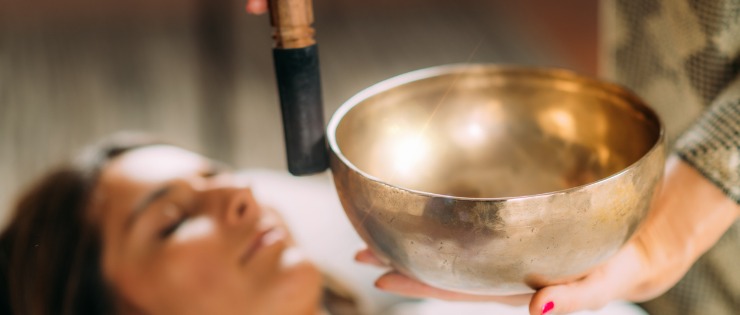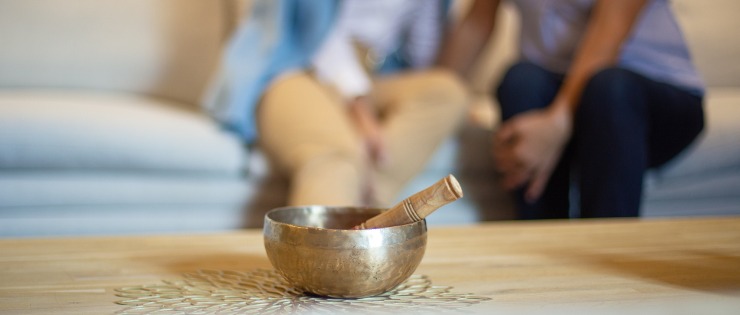
When it comes to relaxing and/or trying to reduce stress, people often look into mindfulness and meditation activities, while some turn to sound. You may not have heard of sound baths, but they aren’t new. Sound bath meditation has been used for thousands of years. In Australia, using sound as a form of therapy dates back 40,000 years with Aboriginal people using the didgeridoo as a sound healing instrument. The ancient Greeks used sound vibration to assist digestion, treat mental disturbance and assist with sleep… but is sound bath meditation still relevant today?
What is Sound Bath Meditation?
Sound bath meditation is where you’re ‘bathed’ in sound waves from voice, gongs, Tibetan singing bowls, crystal singing bowls, dorges (bells), percussion, wind instruments, rattles, cymbals, chimes and tuning forks.
Tibetan singing bowls (also known as Himalayan bowls) are thought to have originated around the 16th century, possibly from China. The bowls were made from mercury, lead, gold, silver, iron and copper. Buddhist monks have long used Tibetan singing bowls for meditation. The bowls grew in popularity as a complementary treatment of ailments in the 1990s.
Today, most singing bowls are made from a bronze alloy of copper, tin, zinc, iron, silver, gold or nickel. Different sounds are produced by striking the bowl or rubbing the rim with a mallet. Different size bowls and their shape and weight produce different sounds. Adding water or accessories to the bowl will change the sound.
Bowls may also be made from crystals and gems. Some people believe that different crystals and gems channel a range of restorative properties. A crystal may absorb negative energy and emit positive energy.

Participation in sound bath meditation is easy. You arrive in comfortable clothing ready to receive sounds around you while you lie down in a relaxed state. For comfort, participants may take a yoga mat, pillow and blanket. A sound bath session may be for one person or a small group. In a group situation, participants may lie in a circle or half circle with their heads in the centre of the circle, close to the musical instruments. In some sessions, participants sit in a comfortable position rather than lie down.
In-person sessions provide vibrations with sound, but listening to a video or online virtual session has reported to be just as successful as in-person sessions for some people. Some people use an online recording as an introduction to sound bath meditation and if they think it has some benefits for them, will progress to a session in a studio.
Sound bath meditation is different to most other wellness programs, but has been likened to acupuncture sessions. Instead of using needles, bowls and instruments are used to produce restorative sound and vibration.
Why Use Sound Bath Meditation?
There are plenty of studies and trials that back the healing properties of sound. The frequency of the sounds affect different organs.

Potential Health Benefits of Sound Bath Meditation
The reported health benefits of sound bath meditation are many and varied. There have been few studies completed on sound bath meditation so the reported health benefits aren’t conclusive.
Anxiety and Depression
A study in 2016 found that anxiety, tension and negative moods decreased significantly after a sound bath. All of the 62 adult participants signalled an increased feeling of spiritual wellbeing after a session. Those who were new to Tibetan singing bowl meditation reported a greater reduction in tension compared to those who had tried this form of meditation before.
In another study that dates back to 2013, singing bowls were used for emotional healing of high-risk youth. The psychotherapy used a combination of deep breathing, visualisation and kindness meditation. It is thought that this combination of healing may start the emotional and psychological healing in counselling sessions.
High Blood Pressure
Research has found that sound baths can impact the nervous system and decrease blood pressure more than traditional meditation. One study reported a greater decline in systolic blood pressure and heart rate with a Himalayan singing bowl compared to silence prior to a directed relaxation session. The report concluded that a Himalayan singing bowl may be used as an adjunct to directed relaxation to produce a physiological and psychological response.

Sleep Disorders
Sleep disorders impact thousands of Australians every year. Sleep debt is not only frustrating for the sufferer, but can lead to a number of health problems including cardiovascular disease, high blood pressure, diabetes, weight gain, neurological disease and psychiatric problems.
Insomnia is most often caused by stress or excessive cortical excitation that can’t be stopped. When the brain is in a constant state of stress, the brain is exhausted but can’t switch off. A sound bath reduces stress levels allowing the brain to switch off, making it possible to fall asleep. Sound meditation engages certain parts of the brain without causing stress so it can relax. Sound baths not only allow insomniacs to fall asleep, it helps provide a deep, beneficial sleep. Some people report needing less sleep per night after sound meditation because their quality of sleep has improved.
Relaxation
Sound bath meditation requires us to unplug and relax. Spending an hour or more lying or sitting down to meditate allows the body and mind to reduce stress levels.
The Risks of Sound Baths
It’s hard to believe that there could be any risks associated with a Himalayan singing bowl, but there are reported side effects.
It has been reported that sound baths can uncover emotions and responses that are buried in the unconscious. It is believed that the vibrations from singing bowls can cause this uncovering. Some people have been surprised to find they had an unexpected reaction such as sadness or panic during a session.
Sound bath therapy shouldn’t be used in place of psychological treatment or counselling, rather it should be in addition to any medication or treatment you may have been prescribed.
Tibetan singing bowls can cause headaches in some people, particularly if a bowl is placed too close to them.
Singing bowls should be avoided by pregnant women, as even weak vibrations from the bowls can have negative effects, especially if a bowl is placed on the body. People with epilepsy should avoid singing bowl therapy as there have been reports of the sound and vibrations causing seizures. People with allergies to metals should avoid placing the bowls on their body to avoid a reaction.
While Tibetan singing bowls aren’t dangerous and don’t cause negative effects for most people, there is little evidence that they are effective; however participants have reported feeling relaxed after a session. The same level of relaxation may be achieved through other activities.

Does Sound Bath Meditation Work for Everyone?
Not everyone achieves a relaxed or meditative state, particularly when they’re new to sound baths. It can take multiple sessions to feel refreshed and relaxed after a sound bath. It can take time to learn how to focus on the sounds and your breathing.
From services for common health needs, to complementary therapies and healthy lifestyle services, our range of extras cover policies will allow you to compare your options and choose the level of cover that suits you. Take a look and find your level today.